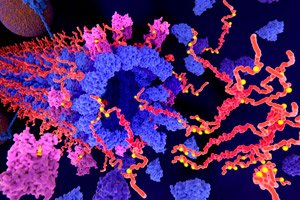
All iLive content is medically reviewed or fact checked to ensure as much factual accuracy as possible.
We have strict sourcing guidelines and only link to reputable media sites, academic research institutions and, whenever possible, medically peer reviewed studies. Note that the numbers in parentheses ([1], [2], etc.) are clickable links to these studies.
If you feel that any of our content is inaccurate, out-of-date, or otherwise questionable, please select it and press Ctrl + Enter.
Glaucoma drug may help prevent buildup of tau protein linked to Alzheimer's disease
Last reviewed: 02.07.2025
 ">
">A recent randomized controlled trial has shown that a drug often used to treat glaucoma protects against the buildup of tau protein in the brain, which causes various forms of dementia and plays a role in Alzheimer's disease.
Researchers at the UK Dementia Research Institute at the University of Cambridge tested more than 1,400 clinically approved drugs using zebrafish genetically modified to mimic so-called tauopathies. They found that drugs known as carbonic anhydrase inhibitors – one of which is the glaucoma drug methazolamide – cleared tau build-up and reduced signs of the disease in zebrafish and mice with mutant forms of tau that cause human dementia.
Tauopathies are neurodegenerative diseases characterized by the accumulation of tau protein aggregates in nerve cells. These diseases include various forms of dementia, Pick's disease, and progressive supranuclear palsy, where tau is considered a major factor in the disease, as well as Alzheimer's disease and chronic traumatic encephalopathy (neurodegeneration caused by repeated head injuries).
The Cambridge team used zebrafish models because they mature quickly and reproduce. This allows them to genetically mimic human diseases, as many genes responsible for human diseases have analogues in zebrafish.
In a study published in the journal Nature Chemical Biology, Professor David Rubinstein, Dr Angelin Fleming and colleagues modelled tauopathy in zebrafish and tested 1,437 drugs clinically approved to treat other diseases.
By inhibiting the enzyme carbonic anhydrase, the team showed that it helps cells clear out the tau protein buildup. It does this by moving lysosomes - the cell's "incinerators" - to the surface, where they fuse with the cell membrane and "push out" the tau.
When the team tested methazolamide in mice genetically modified to carry the P301S mutation, they found that the treated mice performed better on memory tasks and showed improved cognitive function compared to untreated mice.
Analysis of the mice's brains showed that they did indeed have fewer tau aggregates and therefore less of a reduction in brain cells compared to untreated mice.
Methazolamide shows promise as a needed drug to prevent dangerous tau proteins from building up in the brain. The study shows how zebrafish can be used to test existing drugs for repurposing to combat different diseases, potentially significantly speeding up the drug discovery process.
The team hopes to test methazolamide in other disease models, including more common diseases associated with the accumulation of protein aggregates, such as Huntington's disease and Parkinson's disease.
